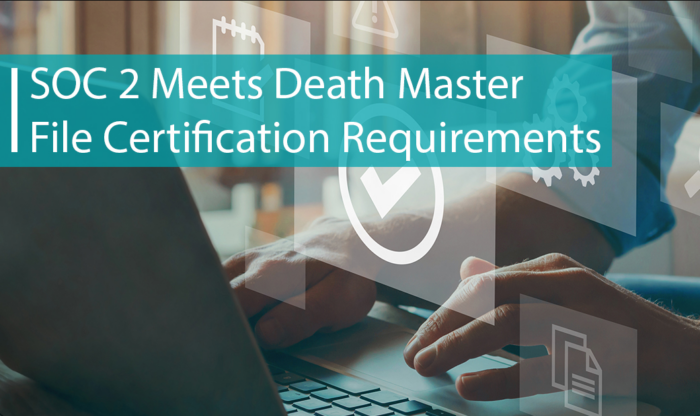The Death Master File, often known as the Social Security Death Index (SSDI), is a vast database that includes invaluable details about deceased individuals. In this article, we will go into the depths of this database, discussing its purposes, objectives, and significance across a range of fields, such as estate planning and genealogy. So, what is the Death Master File and its significance? Let’s investigate these and other issues.
Death Master File: What is it?

Source: aafcpa.com
In the US, the Death Master File, or DMF, is a comprehensive database that gathers essential data about departed people, including names, dates of birth and death, and Social Security numbers. So, what is death master file? Basically, it is a file that its main purpose is to register and monitor the national death population’s demographics.
The File’s Purpose:
The Death Master File’s primary objective is to be a trustworthy resource for confirming people’s deaths. It is critical to the administration of federal programs and benefits, notable among them Social Security. The file is updated frequently to ensure the accuracy of the data it contains. By guaranteeing that no money is given to people who have died fraudulently, so this upholds the system’s integrity.
How is the Death Master File Used?
Now that we are aware of the file’s function, let’s examine its use in several scenarios:
1. Estate Planning:
The Death Master File is crucial when it comes to estate preparation. When someone dies, their estate—which includes both assets and liabilities—must be handled and divided properly. The DMF is used by beneficiaries and executors to confirm the death of the deceased and start the legal procedures associated with estate settlement. In order to follow the legal processes and ensure a seamless transfer of assets to legitimate heirs, this step is essential.
2. Genealogy and Family History:
An indispensable tool for family historians and genealogists is the Death Master File. It provides an immense amount of data, enabling users to explore their ancestors’ birth and death certificates and build a family tree. This can be a huge gold mine for people who want to build family trees and do genealogy research.
3. Preventing Identity Theft:
The Death Master File comes in handy in a time when identity theft in the digital sphere is a major problem. It is used by a variety of businesses and governmental organizations to prevent identity theft by cross-referencing its information with those of living people. This procedure reinforces security protocols and adds another line of defense to the ongoing fight against identity theft in our increasingly linked world by preventing the improper use of deceased people’s identities for fraudulent purposes.
4. Financial Institutions:
The Death Master File is a useful tool used by financial institutions, such as banks and insurance firms, to identify and stop paying out to clients or policyholders who have passed away. These entities uphold the integrity of their financial transactions by regularly cross-referencing their records with the DMF. By maintaining their promise to clients and policyholders, this strategy not only protects their financial interests but also guarantees that money is disbursed appropriately, preventing unjustified disbursements and preserving these institutions’ financial stability.
5. Legal and Law Enforcement:
In a variety of investigations and court cases, law enforcement organizations and legal experts find the Death Master File to be quite helpful. Its contents are a vital source for confirming the identities and other pertinent details of those involved in legal disputes. In order to ensure the fair and just administration of the law, this verification process is essential to preserving the accuracy and dependability of legal processes, from inheritance disputes to criminal investigations.
The Relevance of the Death Master File in Various Industries:

Source: askthedirector.com
The Death Master File is important for more than just one sector of the economy. It affects several industries, including insurance, banking, healthcare, and more, and its effects are profound.
1. Insurance Industry:
Insurance companies use the Death Master File to prevent fraud and make sure life insurance policy payouts are paid out precisely. They are able to process claims with accuracy and honesty because they cross-reference their policyholders with the DMF to confirm the insured’s demise. This procedure helps maintain the insurance industry’s commitment to policyholders and beneficiaries while preserving its financial integrity.
2. Healthcare Sector:
The Death Master File plays a crucial function in the healthcare industry in protecting patient data’ accuracy and preventing false claims. This database is used by healthcare providers to verify the passing of patients and beneficiaries, which helps with proper billing and medical record administration. By guaranteeing the correctness and legality of medical records and financial transactions, this procedure ultimately benefits patients and healthcare organizations by protecting patient data integrity and preventing false or fraudulent claims.
3. Pension and Retirement Funds:
In order to guarantee the financial stability of these programs, pension and retirement funds rely on the Death Master File to verify the passing of plan participants. Through this verification method, these organizations can stop paying pensions as soon as it is confirmed that a person has passed away, avoiding any unnecessary financial outlays. In addition, it protects the deceased’s assets from any potential illegal access, preserving the integrity of retirement payments and providing participants and their beneficiaries with peace of mind.
Conclusion

Source: youngmarrlaw.com
To sum up, the Death Master File, also known as the Social Security Death Index, is a vast database that contains vital information about people who have passed away. Verifying deaths for various administrative objectives is its main goal, protecting the integrity of government programs in the process. It also has uses in estate planning, genealogy, preventing identity theft, and many other fields, such as insurance, healthcare, and finance.
Death Master File is an adaptable tool with broad implications, not just a database of the deceased. Comprehending its importance is essential, as it affects not only the handling of personal and financial matters but also the avoidance of fraud and identity theft in a world growing more interconnected by the day. A testament to the strength of data and its ability to influence our lives even after death is the Death Master File.
Table of Content




